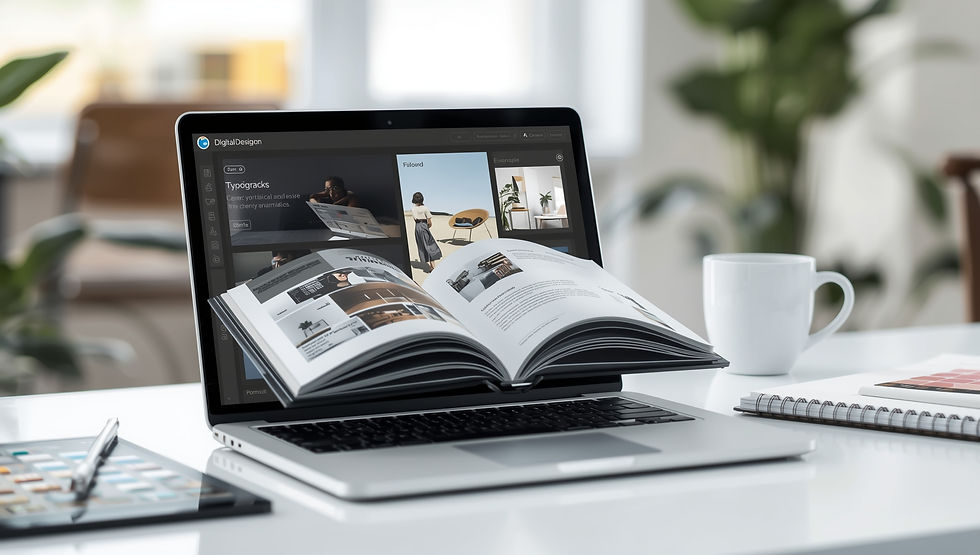How Designers Present Portfolios with Flipbooks: A Step-by-Step Guide
- michaelmalonemarke
- Aug 9
- 3 min read
Still sending flat PDFs or cluttered Google Drive links? There’s a better way to showcase your work flipbooks. A flipbook portfolio is a digital, page-flipping presentation that combines images, text, and interactive features to bring your work to life.
In this guide, you’ll learn how to build a stunning flipbook portfolio, which tools to use, and get inspired by real-world examples. Plus, you’ll see how PDFFlipBook.com can make the process easy and fast.

Why Flipbooks Work for Designers
Flipbooks are perfect for designers because they offer:
Visually appealing presentation - feels like holding a real book or magazine.
Mobile-friendly and browser-based - no downloads or clunky navigation needed.
Interactive features - add clickable links, videos, and animations to engage viewers.
Professional and brandable - customize colors, fonts, and logos to match your style.
If you want a digital portfolio for designers that looks modern and functions smoothly, flipbooks are the way to go. They make your work stand out and create an interactive portfolio experience that employers and clients will remember.
What You Need Before You Start
Before creating your flipbook portfolio, get these ready:
Final portfolio content: images, mockups, and project descriptions.
Exported files: PDFs, PowerPoint files, or JPEG images.
Your brand kit: logo, fonts, and color palette.
Optional extras: intro videos, client testimonials, or links to contact forms.
Having these prepared will make the flipbook creation process smooth and professional.
How to Create Your Flipbook Portfolio Step by Step
Step 1: Organize Your Portfolio Content
Pick your best 5 to 10 projects. For each, write short descriptions explaining the problem, your solution, and the tools you used. Arrange these like a story or case study to keep viewers engaged.
Step 2: Design Your Portfolio Layout
Use design tools like Adobe InDesign, Canva, Figma, or even PowerPoint. Keep your layout clean and consistent with your brand. When done, save your work as a PDF for uploading.
Step 3: Upload to an Online Flipbook Tool
Go to a tool like PDFFlipBook.com, then drag and drop your PDF. The platform will convert your file into a flipbook automatically, ready to share.
Step 4: Add Interactive Features
Make your flipbook dynamic by:
Linking project titles to full case studies or your Behance profile.
Adding buttons like “View Live Site” or “Watch Demo.”
Embedding a short video introduction on the first page to welcome viewers.
Step 5: Customize Your Branding
Add your logo and brand colors. Create a stylish cover page. Choose easy-to-read fonts and layouts that reflect your unique style.
Step 6: Preview and Test
Check your flipbook on phones, tablets, and desktops. Test every link and video to ensure they work well. Check that loading speed and navigation flow are smooth.
How to Share Your Flipbook Portfolio
Once ready, share your portfolio by:
Embedding it on your website or portfolio landing page.
Sending the link in client emails or job applications.
Posting it on LinkedIn or other social media platforms.
Including it in freelancer profiles or proposal packages.
Sharing your flipbook is easy, and it leaves a strong impression.
Realistic Examples: Flipbooks in Action
Emma, the UI Designer: Emma adds a video walkthrough of her app design in her flipbook. Recruiters say it stood out because it felt “alive” compared to usual portfolios.
Luis, the Freelance Illustrator: Luis uses a flipbook as a virtual artbook. Each page shows his illustrations with a story. He includes it in artist job applications.
Tara, the Student Designer: Tara presents school projects with clean pages and color-coded sections. She adds a contact form link and lands two internships.
Tips for a Great Flipbook Portfolio
Keep pages simple and clean avoid clutter.
Use calls-to-action like “Contact Me” or “See Full Project.”
Use high-quality images, but optimize them for fast loading.
Keep your flipbook short aim for 10 to 20 pages max.
Conclusion + Call to Action
Flipbooks help designers present work beautifully, interactively, and professionally. If you want your portfolio to impress and engage, flipbooks are a smart choice.
Ready to create your own? Try making a flipbook portfolio today at PDFFlipBook.com no downloads or tech skills needed!
FAQ: Quick Answers
Q1: Can I use a flipbook portfolio on Behance or Dribbble? Yes! Just add the flipbook link to your profile or project descriptions to showcase your interactive portfolio.
Q2: Do I need design software to make a flipbook? Not necessarily. You can design in Canva or PowerPoint, export as PDF, then upload to a flipbook tool.
Q3: Is a flipbook portfolio mobile-friendly?
Absolutely! Flipbooks created with PDFFlipBook.com work smoothly on all modern devices and browsers.





Comments